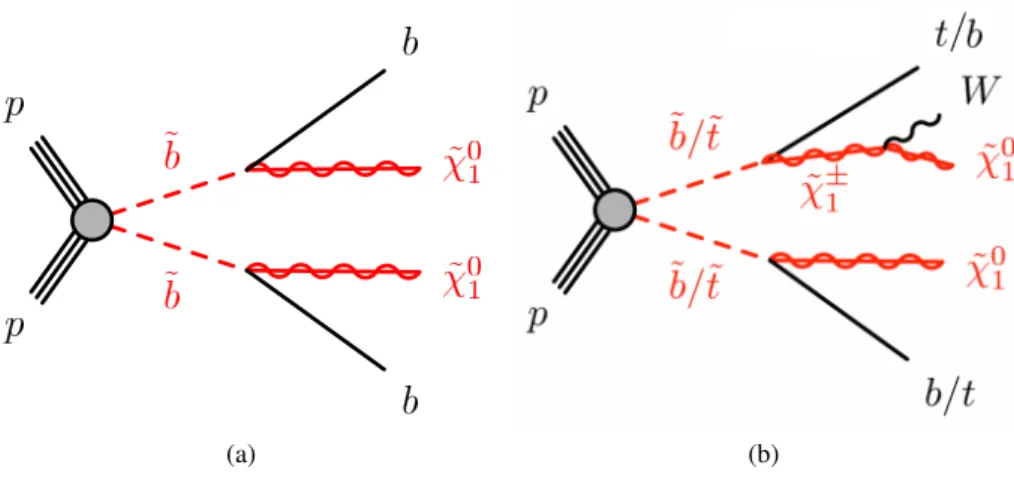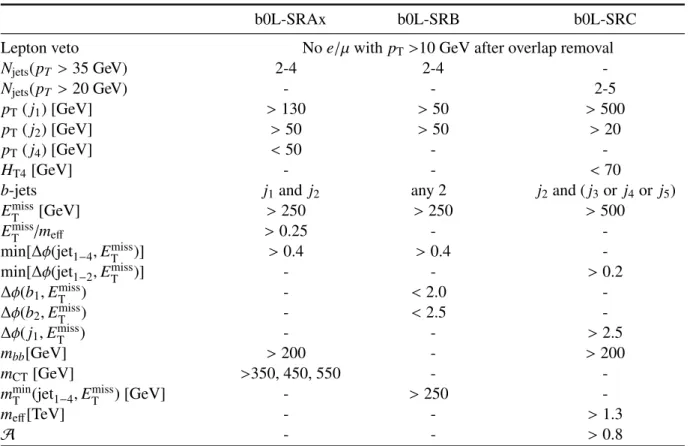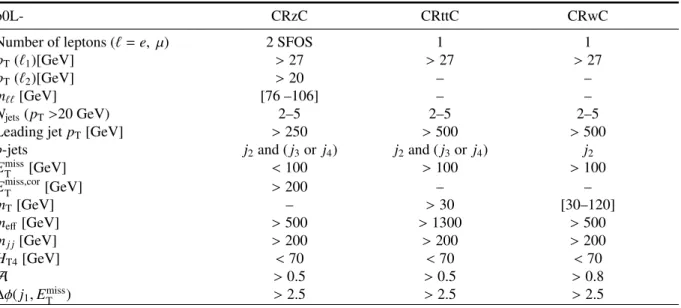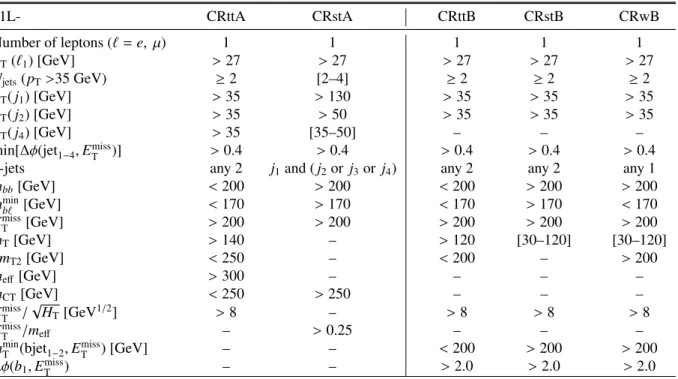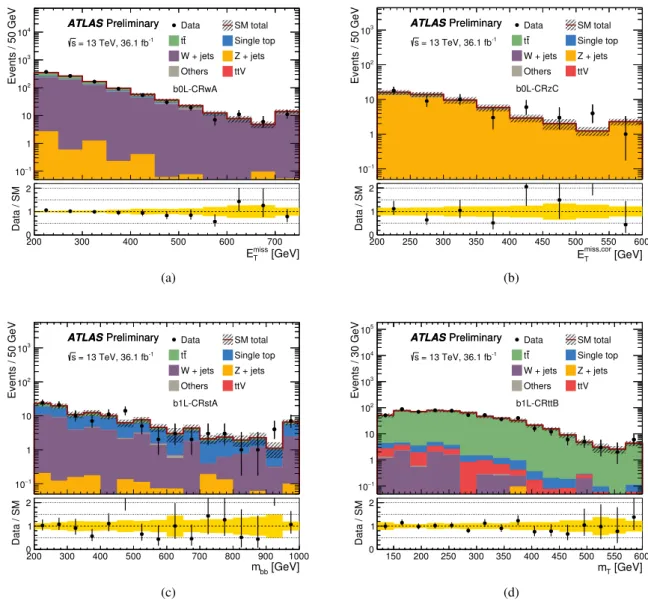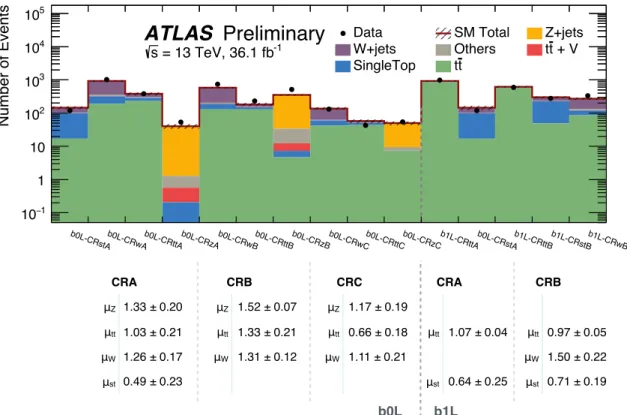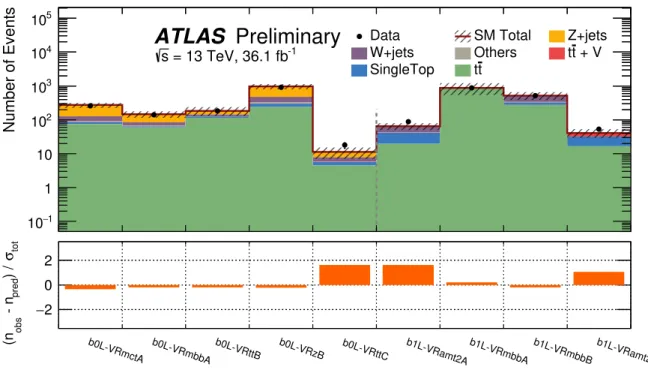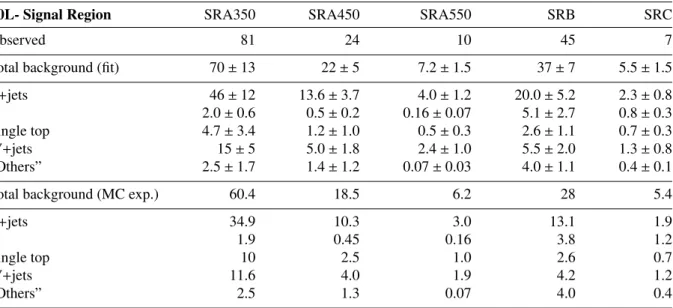ATLAS-CONF-2017-038 30May2017
ATLAS CONF Note
ATLAS-CONF-2017-38
22nd May 2017
Search for supersymmetry in events with b-tagged jets and missing transverse momentum in pp collisions at √
s = 13 TeV with the ATLAS detector
The ATLAS Collaboration
A search for the supersymmetric partner of the Standard Model bottom and top quarks is presented. The search uses 36.1 fb−1 ofppcollision data at √
s = 13 TeV collected by the ATLAS experiment at the Large Hadron Collider. Direct production of pairs of bottom and top squarks (˜b1and ˜t1) is searched for in final states withb-tagged jets and missing transverse momentum. Distinctive selections are defined with either no charged leptons (electrons and muons) in the final state, or one charged lepton. The zero-lepton selection targets models in which the ˜b1 is the lightest squark and decays via ˜b1 → bχ˜01, where ˜χ01 is the lightest neutralino. The one-lepton final state targets models where bottom or top squarks are pro- duced and can decay into multiple channels, ˜b1 → bχ˜01 and ˜b1 → tχ˜±1, or ˜t1 → tχ˜01 and t˜1 → bχ˜±1, where ˜χ±1 is the lightest chargino and the mass differencemχ˜±
1 −mχ˜0
1 is set to 1 GeV. No excess above the expected Standard Model background yields is observed. Exclu- sion limits at 95% confidence level on the mass of the bottom squark are derived in various supersymmetry-inspired simplified models.
c
2017 CERN for the benefit of the ATLAS Collaboration.
Reproduction of this article or parts of it is allowed as specified in the CC-BY-4.0 license.
Contents
1 Introduction 2
2 ATLAS detector 4
3 Data and simulated event samples 4
4 Event reconstruction 6
5 Event selection 8
5.1 Discriminating variables 8
5.2 Zero-lepton channel selections 10
5.3 One-lepton channel selections 11
6 Background estimation 12
6.1 Background estimation in the zero-lepton signal regions 13 6.2 Background estimation in the one-lepton signal regions 15
6.3 Validation regions 16
7 Systematic uncertainties 18
8 Results and interpretation 21
9 Conclusion 26
1 Introduction
Supersymmetry (SUSY) [1–6] provides an extension of the Standard Model (SM) that solves the hier- archy problem [7–10] by introducing partners of the known bosons and fermions. In the framework of theR-parity-conserving models, SUSY particles are produced in pairs and the lightest supersymmetric particle (LSP) is stable, providing a possible candidate for dark matter [11,12]. In a large variety of models the LSP is the lightest neutralino ( ˜χ01). Naturalness considerations [13,14] suggest that the super- symmetric partners of the third-generation SM quarks are the lightest coloured supersymmetric particles.
This may lead to the lightest bottom squark (˜b1) and top squark (˜t1) mass eigenstates1being significantly lighter than the other squarks and the gluinos. As a consequence, ˜b1 and ˜t1 could be pair-produced with relatively large cross-sections at the Large Hadron Collider (LHC).
This paper presents a search for the direct pair production of bottom and top squarks decaying into final states with jets, two of them originating from the fragmentation ofb-quarks (b-jets), and missing trans- verse momentum (pmissT , whose magnitude is referred to asEmissT ). The dataset analysed corresponds to 36.1 fb−1 of proton–proton (pp) collisions at √
s = 13 TeV collected by the ATLAS experiment during Run-2 of the LHC in 2015 and 2016. The third generation squarks are assumed to decay to the light- est neutralino (LSP) directly or through one intermediate stage. The search targets models inspired by the minimal supersymmetric extension of the SM (MSSM) [15–17], where the ˜b1exclusively decays as
1Scalar partners of the left-handed and right-handed chiral components of the bottom quark (˜bL,R) or top quark (˜tL,R) mix to form mass eigenstates for which ˜b1and ˜t1are defined as the lighter of the two.
(a) (b)
Figure 1: Diagrams illustrating the signal scenarios considered for the pair production of bottom and top squarks targetted by the (a) zero-lepton and (b) one-lepton channel selections. In (a) bottom squarks decay to a bottom-quark and the lightest neutralino. In (b), decays via intermediate charginos compete. If the mass difference∆m( ˜χ±1,χ˜01) is small,Wfrom chargino decays are off-shell.
b˜1 → bχ˜01 or where two decay modes for the bottom (top) squark are allowed and direct decays to the LSP compete with decays via an intermediate chargino ( ˜χ±1) state, ˜b1 → bχ˜01 and ˜b1 → tχ˜±1 (˜t1 → tχ˜01 and ˜t1 → bχ˜±1). In this case it is assumed that the ˜χ±1 is the next-to-lightest supersymmetric particle (NLSP) and is almost degenerate with ˜χ01, such that other decay products have too low momenta to be efficiently reconstructed. The first set of models lead to final state events for bottom-squark pair produc- tion characterized by the presence of twob-jets,EmissT and no charged leptons (` = e, µ), referred to as zero-lepton channel (Figure1(a)). For mixed decays (direct or through an intermediate stage), the final state of bottom- and top-squark pair production depends on the branching ratio of the competing decay modes. If they are equally probable, a large fraction of signal events is characterised by the presence of a top quark, a bottom quark, and neutralinos. Hadronic decays of the top-quark are targeted by the zero-lepton channel, whilst a dedicated selection requiring one charged lepton, twob-jets andEmissT is de- veloped for leptonic decays of the top-quark, referred to as one-lepton channel (Figure1(b)). A statistical combination of the two channels is performed when interpreting the results in terms of exclusion limits on the third generation squark masses.
Previous searches for ˜b1 → bχ˜01 with the √
s = 13 TeV LHC Run-2 dataset at ATLAS and CMS have set exclusion limits at 95% confidence level (CL) on ˜b1masses in such scenarios. For ˜χ01masses around 100 GeV, limits at 95% to 840 GeV and 960 GeV have been reported by the ATLAS [18] and CMS [19]
collaborations, respectively, using 3.2 fb−1(ATLAS) and 35.9 fb−1(CMS) of data. Searches for the mixed decay models were performed by ATLAS using the Run-1 √
s=8 TeV dataset and resulted in exclusion limits on the third generation squark mass of up to 550 GeV depending on the branching ratio of the competing decay modes [20].
2 ATLAS detector
The ATLAS detector [21] is a multi-purpose particle physics detector with a forward-backward symmetric cylindrical geometry and nearly 4πcoverage in solid angle.2 The inner tracking detector consists of pixel and silicon microstrip detectors covering the pseudorapidity region|η| < 2.5, surrounded by a transition radiation tracker which enhances electron identification in the region |η| < 2.0. Between Run-1 and Run-2, a new inner pixel layer, the Insertable B-Layer (IBL) [22], was inserted at a mean sensor radius of 3.3 cm. The inner detector is surrounded by a thin superconducting solenoid providing an axial 2 T magnetic field and by a fine-granularity lead/liquid-argon (LAr) electromagnetic calorimeter covering
|η| < 3.2. A steel/scintillator-tile calorimeter provides hadronic coverage in the central pseudorapidity range (|η| < 1.7). The endcap and forward regions (1.5 < |η| < 4.9) of the hadronic calorimeter are made of LAr active layers with either copper or tungsten as the absorber material. An extensive muon spectrometer with an air-core toroid magnet system surrounds the calorimeters. Three layers of high- precision tracking chambers provide coverage in the range|η|<2.7, while dedicated fast chambers allow triggering in the region|η|<2.4. The ATLAS trigger system consists of a hardware-based level-1 trigger followed by a software-based high-level trigger (HLT) [23].
3 Data and simulated event samples
The data used in this analysis were collected by the ATLAS detector in ppcollisions at the LHC with a centre-of-mass energy of 13 TeV and a 25 ns proton bunch crossing interval during 2015 and 2016.
The full dataset corresponds to an integrated luminosity of 36.1 fb−1after requiring that all detector sub- systems were operational during data recording. The uncertainty in the combined 2015+2016 integrated luminosity is 3.2%. It is derived following a methodology similar to that detailed in Ref. [24] from a preliminary calibration of the luminosity scale using x−ybeam-separation scans performed in August 2015 and May 2016. Each event includes on average 13.7 and 24.9 inelasticppcollisions (“pileup”) in the same bunch crossing in the 2015 and 2016 dataset, respectively. In the zero-lepton channel events are required to pass anETmisstrigger [25]. These triggers are fully efficient for events passing the preselection defined in Section5, which requires the offline reconstructedEmissT to exceed 200 GeV. Events in the one- lepton channel, as well as events used for control regions, are selected online by a trigger requiring the presence of one electron or muon. The online selection thresholds are such that a plateau of the efficiency is reached for charged lepton transverse momenta of 27 GeV.
Monte Carlo (MC) samples of simulated events are used to model the signal and to aid in the estimation of SM background processes, except multijet processes which are estimated from data only. All simulated events are passed through the full detector simulation using GEANT4 [26], or through a faster simulation based on a parameterization [27] for the calorimeter response and GEANT4 for the other detector systems.
The simulated events are reconstructed with the same algorithm as that used for data.
2ATLAS uses a right-handed coordinate system with its origin at the nominal interaction point in the centre of the detector.
The positivex-axis is defined by the direction from the interaction point to the centre of the LHC ring, with the positivey-axis pointing upwards, while the beam direction defines thez-axis. Cylindrical coordinates (r, φ) are used in the transverse plane,φ being the azimuthal angle around thez-axis. The pseudorapidityηis defined in terms of the polar angleθbyη=−ln tan(θ/2).
Rapidity is defined asy=0.5 ln[(E+pz)/(E−pz)] whereEdenotes the energy andpzis the component of the momentum along the beam direction.
SUSY signal samples are generated with MadGraph5_aMC@NLO [28] v2.2.3 at leading-order (LO) and interfaced to Pythia8.186 [29] with the A14 [30] set of parameters (tune) for the modelling of the parton showering (PS), hadronization and underlying event. The matrix element (ME) calculation is performed at tree level and includes the emission of up to two additional partons. The ME–PS match- ing is done using the CKKW-L [31] prescription, with a matching scale set to one quarter of the third generation squark mass. The NNPDF23LO [32] parton density function (PDF) set is used. The cross- sections used to evaluate the signal yields are calculated to next-to-leading-order (NLO) accuracy in the strong coupling constant, adding the resummation of soft gluon emission at next-to-leading-logarithmic accuracy (NLO+NLL) [33–35]. The nominal cross-section and uncertainty are taken as the midpoint and half-width of an envelope of cross-section predictions using different PDF sets and factorisation and renormalisation scales, as described in Ref. [36].
SM background samples are simulated using different MC generator programs depending on the process.
The generation oft¯tpairs and single top-quarks in the Wt and s-channels is made using the Powheg- Box[37] v2 generator with the CT10 [38] PDF set for the matrix element calculations. Electroweak t-channel single top-quark events are generated using the Powheg-Boxv1 generator. For all processes in- volving top quarks, top-quark spin correlations are preserved. The parton shower, fragmentation, and the underlying event are simulated using Pythia6.428 [39] with the CTEQ6L1 PDF set. Thehdampparameter in Powheg, which controls thepTof the first additional emission beyond the Born level and thus regulates thepTof the recoil emission against thet¯tsystem, is set to the mass of the top quark (mtop = 172.5 GeV).
All events with at least one leptonically decayingWboson are included. Fully hadronict¯tand single top events do not contain sufficientETmiss to contribute significantly to the background. The t¯t samples are normalized to their next-to-NLO (NNLO) cross-section including the resummation of soft gluon emission at next-to-NLL accuracy using Top++2.0 [40]. Samples of single-top-quark production are normalized to the NLO cross-sections reported in Refs. [41–43] for thes-,t- andWt-channels, respectively.
Events containingW orZ bosons with associated jets, including jets from the fragmentation ofb- and c-quarks, are simulated using the Sherpav2.2.1 [44] generator. Matrix elements are calculated for up to two additional partons at NLO and four partons at LO using the Comix[45] and OpenLoops[46] matrix element generators and merged with the SherpaPS [47] using the ME+PS@NLO prescription [48]. The NNPDF30NNLO [32] PDF set is used in conjunction with a dedicated PS tune developed by the Sherpa authors. Additional SherpaZ+jets samples were produced with similar settings but with up to four partons LO, for theγ+jets studies detailed in Section6. TheW/Z+jets events are normalized to their NNLO QCD theoretical cross-sections [49].
Diboson processes are also simulated using the Sherpagenerator using the NNPDF30NNLO PDF set in conjunction with a dedicated PS tune developed by the Sherpaauthors. They are calculated for up to one (ZZ) or zero (WW,WZ) additional partons at NLO and up to three additional partons at LO.
Additional contributions to the SM backgrounds in the signal regions arise from the production oft¯tpairs in association withW/Z/hbosons and possibly additional jets. The production oft¯tpairs in association with electroweak vector bosonsW and Z and Higgs boson is modeled by samples generated at NLO using MadGraph5_aMC@NLO v2.2.3 and showered with Pythia v8.212. Other potential sources of backgrounds, such as the production of three or four top quarks or three gauge bosons, are found to be negligible.
For all samples, except the ones generated using Sherpa, the EvtGen v1.2.0 program [50] is used to simulate the properties of the bottom and charm-hadron decays. All Pythiav6.428 samples use the PER- UGIA2012 [51] tune for the underlying event, while Pythiav8.186 and Herwig++showering are run
with the A14 and UEEE5 [52] underlying-event tunes, respectively. In-time and out-of-time pileup in- teractions from the same or nearby bunch-crossings are simulated by overlaying additionalppcollisions generated by Pythiav8.186, and the MSTW2008LO [53] parton distribution function set, superimposed onto the hard scattering events to reproduce the observed distribution of the average number of interac- tions per bunch crossing [54].
Several samples produced without detector simulation are employed to derive systematic uncertainties associated with the specific configuration of the MC generators used for the nominal SM background samples. They include variations of the renormalization and factorization scales, the CKKW-L matching scale, as well as different PDF sets and fragmentation/hadronization models. Details of the MC modelling uncertainties are discussed in Section7.
4 Event reconstruction
The search for pair production of bottom and top squarks is based on two distinctive selections of events withb-jets and large missing transverse momentum, with either no charged leptons in the final state, or requiring exactly one electron or muon. For the zero-lepton channel selection, events containing charged leptons are explicitly vetoed in the signal and validation regions. Events characterized by the presence of exactly one electron or muon with transverse momentum above 27 GeV are retained in the one-lepton selection and are also used to define control regions for the zero-lepton channel. Finally, same-flavour opposite-sign (SFOS) two-lepton (electron or muon) events with dilepton invariant mass near theZboson mass are used for control regions employed to aid in the estimate of theZ+jets background. The details of the selections and the reconstructed objects as well as the overlap removal procedure applied to prevent their double-counting are given below.
Selected events are required to have a reconstructed primary vertex consistent with the beamspot envelope and to consist of at least two tracks in the inner detector withpT >0.4 GeV. When more than one such vertex is found the one with the largest sum of the squares of transverse momenta of associated tracks [55]
is chosen.
Jet candidates are reconstructed from three-dimensional energy clusters [56] in the calorimeter using the anti-ktjet algorithm [57] with a distance parameter of 0.4. Each topological cluster’s energy is calibrated to the electromagnetic scale prior to jet reconstruction. The reconstructed jets are then calibrated to the particle level by the application of a jet energy scale (JES) derived from √
s = 13 TeV data and simu- lations [58]. Quality criteria are imposed to identify jets arising from non-collision sources or detector noise and any event containing such a jet is removed [59]. Further track-based selections are applied to reject jets withpT < 60 GeV and|η|< 2.4 that originate from pile-up interactions [60] and the expected event average energy contribution from pile-up clusters is subtracted using the jet area method [61]. Jets are classified as “baseline” and “signal”. Baseline jets are required to havepT > 20 GeV and|η| < 4.8.
Signal jets, selected after resolving overlaps with electrons and muons, are required to pass the stricter requirement ofpT >35 GeVand|η|<2.8.
Jets are identified asb-jets if tagged by a multivariate algorithm which uses information about the impact parameters of inner detector tracks matched to the jet, the presence of displaced secondary vertices, and the reconstructed flight paths ofb- andc-hadrons inside the jet [62]. Theb-tagging working point with a 77% efficiency, as determined in a sample of simulatedt¯tevents, was chosen as part of the optimization procedure. The corresponding rejection factors against jets originating from c-quarks and from light
quarks and gluons at this working point are 6.2 and 134, respectively [63]. To compensate for differences between data and MC simulation in theb-tagging efficiencies and mis-tag rates, correction factors derived from data and are applied to the samples of simulated events [62]. Candidateb-jets are required to have pT >50 GeV and|η|<2.5.
Electron candidates are reconstructed from energy clusters in the electromagnetic calorimeter matched to a track in the inner detector and are required to satisfy a set of “loose” quality criteria [64–66]. They are also required to lie within the fiducial volume|η| < 2.47. Muon candidates are reconstructed from matching tracks in the inner detector with tracks in the muon spectrometer. Events containing one or more muon candidates that have a transverse (longitudinal) impact parameter with respect to the primary vertex larger than 0.2 mm (1 mm) are rejected to suppress muons from cosmic rays. Muon candidates are also required to satisfy “medium” quality criteria [67] and have|η|<2.5. All electron and muon candidates must havepT >10 GeV. Lepton candidates remaining after resolving the overlap with baseline jets (see next paragraph) are called “baseline” leptons. In the control and signal regions where lepton identification is required, “signal” leptons are chosen from the baseline set withpT >27 GeV to ensure full efficiency of the trigger and are required to be isolated from other objects using a criterion designed to accept at least 95% of leptons fromZboson decays as detailed in Ref. [68]. The angular separation between the lepton and theb-jet arising from a leptonically decaying top quark will narrow as the top pT increases.
This increased collimation is accounted for by varying the radius of the isolation cone as max(0.2, 10 GeV/plepT ), where plepT is the lepton pT. Signal electrons are further required to satisfy “tight” quality criteria. Electrons (muons) are matched to the primary vertex by requiring the transverse impact parameter (d0) to satisfy|d0/σ(d0)|<5 (3), and the longitudinal impact parameter (z0) to satisfy|z0sinθ|<0.5 mm for both the electrons and muons. The MC events are corrected to account for differences in the lepton trigger, reconstruction and identification efficiencies between data and MC simulation.
The sequence to resolve overlapping objects begins by removing electron candidates sharing an inner detector track with a muon candidate. Next, jet candidates within∆R = p
(∆y)2+(∆φ)2 = 0.2 of an electron candidate are discarded, unless the jet isb-tagged, in which case the electron is discarded since it is likely to originate from a semileptonicb-hadron decay. Finally, electrons are discarded if they lie within∆R = 0.4 of a jet, whilst muons with pT below (above) 50 GeV are discarded if they lie within
∆R=0.4 (∆R=min(0.4,0.04+10 GeV/pT)) of any remaining jet, except for the case where the number of tracks associated with the jet is less than three.
The missing transverse momentum is defined as the negative vector sum of the pT of all selected and calibrated physics objects in the event, with an extra term added to account for soft energy in the event which is not associated with any of the selected objects. This soft term is calculated from inner detector tracks with pT above 0.4 GeV matched to the primary vertex to make it more robust against pile-up contamination [69,70].
Reconstructed photons are not used in the main signal event selections but are selected in the regions em- ployed in one of the alternative methods used to check theZ+jets background, as explained in Section6.
Photon candidates are required to have pT > 10 GeV and|η| < 2.37, whilst being outside the transition region 1.37<|η|<1.52, to satisfy the tight photon shower shape and electron rejection criteria [71]. The photons used in this analysis are further required to havepT>130 GeV and to be isolated.
5 Event selection
Two sets of signal regions (SRs) are defined and optimised to target different third generation squark decay modes and mass hierarchies of the particles involved. The zero-lepton channel SRs (b0L) are set to maximize the efficiency to retain bottom-squark pair production events where ˜b1→bχ˜01. The one-lepton channel selections (b1L) target SUSY models where bottom squarks decay with significant branching ratio as ˜b1 → tχ˜±1 and the lightest chargino is almost degenerate with the lightest neutralino. Under these assumptions, the final decay products of the off-shellWboson from ˜χ±1 →χ˜01W∗are too soft to be detected. If the branching ratio of the two competing decay modes (bχ˜01,tχ˜±1) is around 50%, the final state of the largest fraction of signal events is characterised by the presence of a top quark, a bottom quark, and neutralinos escaping the detector. Similarly, ˜t1pair production can lead to an equivalent final state if ˜t1 →tχ˜01and ˜t1→bχ˜±1 decay modes compete.
5.1 Discriminating variables
Several kinematic variables and angular correlations, built from the physics objects defined in the previous section, are employed to discriminate SUSY from SM background events and are reported below. In the following signal jets are used and are ordered according to decreasingpT.
• min[∆φ(jet1−4,EmissT )], min[∆φ(jet1−2,ETmiss)]: These variables are the minimum ∆φ between any of the leading jets and the missing transverse momentum vector. The background from multijet processes is characterised by small values of this variable. Depending on the signal regions, four or two jets are used.
• HT: This is defined as the scalar sum of thepTof all jets in the event
HT =X
i
(pjetT)i,
where the number of jets involved depends on the signal region. In addition, the modified form of HT, referred to as the HT4 variable, is used to reject events with extra-jet activity in signal regions targeting models characterized by small mass splitting between the bottom squark and the neutralino. InHT4the sum starts on the fourth jet (if any).
• meff: This is defined as the scalar sum of the pTof the leading four jets and theEmissT , i.e.:
meff =X
i≤4
(pjetT )i+ETmiss.
Themeff observable is correlated with the mass of the pair-produced SUSY particles and is em- ployed as discriminating variable in some of the zero-lepton and one-lepton channels selections, as well as in the computation of other complex observables.
• ETmiss/meff, EmissT /√
HT : The first ratio is the fraction of theEmissT over themeff, while the second emulates the global EmissT significance, given that the ETmiss resolution scales approximately with the square root of the total hadronic energy in the event. Events with lowEmissT significance are rejected as it is most probable thatETmissarises from jets mis-measurements, caused by instrumental and resolution effects.
• mj j : This is a selection on the invariant mass of the leading two jets. In events where at least one of the leading jets isb-tagged, this variable aids in reducing the contamination fromt¯tevents. It is referred to asmbbfor events with twob-tagged jets.
• mT: The event transverse massmT is defined asmT = q
2plepT EmissT −2plepT ·pmissT and is used in one-lepton control and signal regions to reduceW+jets andt¯tbackground events.
• mminb` : The minimum invariant mass of the lepton and one of the twob-jets is defined as:
mminb` =mini=1,2 m`bi. This variable is bound from above to
q
m2t −m2W for t¯tproduction, and it is used to distinguish t¯t contributions from single-top-quark production events from the Wt channel in the one-lepton control regions.
• Contransverse mass (mCT) [72]: This is the main discriminating variable in most of the zero-lepton channel signal regions [73]. It is used to measure the masses of pair-produced semi-invisibly de- caying heavy particles. For two identical decays of heavy particles (e.g. the bottom squarks for exclusive decays as ˜b1→bχ˜01) into two visible particlesv1andv2(theb-quarks), and two invisible particlesX1andX2(the ˜χ01for the signal),mCT is defined as
m2CT(v1, v2)=[ET(v1)+ET(v2)]2−[pT(v1)−pT(v2)]2, withET= q
p2T+m2, and it has a kinematical endpoint atmmaxCT = m2im−mi 2X whereiis the initially pair produced particle. This variable is extremely effective in suppressing the top-quark pair production background (i=t,X =W), for which the endpoint is at 135 GeV.
• min[mT(jet1−4,EmissT )] : It is the minimum transverse mass of the leading four jets and theETmissin the event. For signal scenarios with low values ofmmaxCT , this kinematic variable is an alternative discriminating variable to reduce thet¯tbackground.
• amT2: The asymmetric transverse mass [74,75] is a kinematic variable which can be used to sep- arate processes in which two decays giving missing transverse momentum occur and it is the main discriminant observable in the one-lepton channel signal regions. TheamT2 definition is based on the stransverse mass (mT2) [76]:
m2T2(χ)= min
q(1)T +q(2)T =pmissT
hmaxn
m2T(pT(v1),q(1)T ;χ),m2T(pT(v2),q(2)T ;χ)oi ,
wherepT(vi) are reconstructed transverse momenta vectors andq(i)T represent the missing transverse momenta from the two decays, with a total missing transverse momentum,pmissT ;χis a free para- meter representing the unknown mass of the invisible particles – here assumed to be zero. Thea inamT2 indicates that the two visible decay legs are asymmetric, i.e. not composed of the same particles.
In the case of events with one lepton (electron or muon) and twob-jets, the mT2 is calculated for different values of pT(v1) andpT(v2), by grouping the lepton and the two b-jets into two visible objectsv1andv2. The lepton needs to be paired with one of the twob-jets and the choice is driven by the value ofmbl(n) - the invariant mass of thenthb-tagged jet and the lepton. If the two particles are correctly coupled, this value has an upper bound given by the top quark mass. The value of amT2is thus computed accordingly:
– Ifmbl (1) andmbl (2) are both> 170 GeV, none of the two couplings is compatible with the b-jet and the lepton originating from a top decay, therefore the event is rejected as all control, validation and signal regions contain a cut on the minimum value ofmbl to be<170 GeV.
– Ifmbl (1) is< 170 GeV andmbl (2) is> 170 GeV,amT2 is calculated withv1 = b1+land v2=b2. This is done because only the first pairing is compatible with a top quark decay.
– Similarly, ifmbl(1) is> 170 GeV andmbl(2) is<170 GeV,amT2 is calculated withv1 = b1 andv2=b2+l.
– Ifmbl (1) andmbl (2) are both< 170 GeV, amT2is calculated in both configurations and its value it taken to be the minimum of the two. This must be done since according to thembl
check both pairings would be acceptable.
• A: This is thepTasymmetry of the leading two jets and is defined as:
A= pT(j1)−pT(j2) pT(j1)+pT(j2).
TheAvariable is employed in scenarios where the mass splitting between the bottom squark and the neutralino is small (<20 GeV) and the selection exploits the presence of a high momentum jet from initial state radiation.
5.2 Zero-lepton channel selections
The selection criteria for the zero-lepton channel SRs are summarized in Table 1 and have the main requirement of no baseline leptons withpT > 10 GeV. To exploit the kinematic properties over the large range of ˜b1and ˜χ01masses explored, three sets of SRs have been defined.
The b0L-SRA regions are optimized to be sensitive to models with large mass splitting between the b˜1 and the ˜χ01, ∆m(˜b1,χ˜01) > 250 GeV. Incremental thresholds are applied on the main discriminating variable, mCT, resulting in three overlapping regions (mCT >350, 450 and 550 GeV). Only events with ETmiss>250 GeV are retained to ensure full efficiency of the trigger and comply with the expected signal topology. Two high pT b-tagged jets are required whilst contamination from backgrounds with high jet multiplicity, particularlyt¯tproduction, is suppressed by vetoing events with a fourth jet withpT >50 GeV.
To discriminate against multijet background, events whereEmissT is aligned with a jet in the transverse plane are rejected by requiring∆φminj > 0.4, andEmissT /meff >0.25. A selection on the invariant mass of the twob-jets (mbb > 200 GeV) is applied to further enhance the signal yield over the SM background contributions.
The b0L-SRB region targets intermediate mass splitting between ˜b1and ˜χ01, 50<∆m(˜b1,χ˜01)<250 GeV.
In these scenarios, the selections based on the mCT and mbb variables are no longer effective and the variable min[mT(jet1−4,ETmiss)] is employed to reduce SM background contributions fromt¯tproduction, with events selected if min[mT(jet1−4,ETmiss)] >250 GeV. Up to four jets with pT>35 GeV are allowed, to reduce additional hadronic activity in the selected events. As opposed to the b0L-SRA criteria, no veto of the fourth jet pT is applied. A series of selections on the azimuthal angle between the twob-tagged jets and the EmissT are implemented (|∆φ(b1,EmissT )| < 2.0 and |∆φ(b2,EmissT )| < 2.5) to reduce Z+jets background events.
Finally, the b0L-SRC region targets events where a bottom squark pair is produced in association with a jet from initial-state radiation (ISR). This selection provides sensitivity to models with a small mass difference between the ˜b1 and the ˜χ01, ∆m(˜b1,χ˜01) < 50 GeV, such that a boosted bottom squark pair would satisfy the trigger requirements. To suppress efficientlyt¯t andW+jets backgrounds, events are selected with one highpTnon-b-tagged jet andEmissT >500 GeV such that∆φ(j1,EmissT )>2.5. Stringent requirements on the minimum azimuthal distance between the jets andEmissT are found to be not suited for these scenarios whereb-jets have softer momenta and are possibly aligned toETmiss. A large asymmetry Ais required to reduce multijet background while loosening the selection on the minimum azimuthal distance between the jets andEmissT to min[∆φ(jet1−2,ETmiss)]>0.2, while the pT threshold on signal jets is relaxed to 20 GeV.
Table 1: Summary of the event selection in each signal region for the zero-lepton channel. The term lepton is used in the table to refer to baseline electrons and muons. Jets (j1, j2, j3, j4 and j5) are labelled with an index corresponding to their decreasing order inpT.
b0L-SRAx b0L-SRB b0L-SRC
Lepton veto Noe/µwith pT>10 GeV after overlap removal
Njets(pT >35 GeV) 2-4 2-4 -
Njets(pT >20 GeV) - - 2-5
pT(j1) [GeV] >130 >50 >500
pT(j2) [GeV] >50 >50 >20
pT(j4) [GeV] <50 - -
HT4[GeV] - - <70
b-jets j1and j2 any 2 j2and (j3or j4or j5)
ETmiss[GeV] >250 >250 >500
ETmiss/meff >0.25 - -
min[∆φ(jet1−4,EmissT )] >0.4 >0.4 -
min[∆φ(jet1−2,EmissT )] - - >0.2
∆φ(b1,ETmiss) - <2.0 -
∆φ(b2,ETmiss) - <2.5 -
∆φ(j1,EmissT ) - - >2.5
mbb[GeV] >200 - >200
mCT [GeV] >350, 450, 550 - -
mminT (jet1−4,EmissT ) [GeV] - >250 -
meff[TeV] - - >1.3
A - - >0.8
5.3 One-lepton channel selections
The selection criteria for the one-lepton channel SRs are summarized in Table2. Events are required to have exactly one signal electron or muon and no additional baseline leptons, twob-tagged jets and a largeEmissT . Similarly to the zero-lepton channel, three sets of SRs are defined to maximize the sensitivity depending on the mass hierarchy between ˜b1(˜t1) and ˜χ±1 ≈χ˜01.
The b1L-SRA regions are optimized for models with large∆m(˜b1,χ˜01): events are required to have large ETmiss and EmissT /√
HT, two b-tagged jets and min[∆φ(jet1−4,ETmiss)] above 0.4 to reduce multijet back- ground contributions to negligible levels. Requirements on themT andamT2 variables to be above 140 GeV and 250 GeV, respectively, are set to rejectW+jets andt¯tevents whilst the selection on the invari- ant mass of the twob-jets (mbb > 200 GeV) is applied to further enhance the signal yield over the SM background contributions. Two incremental thresholds are finally applied onmeff (600 and 750 GeV) to define two overlapping signal regions.
The b1L-SRB region is designed to be sensitive to compressed mass spectra, hence lowmbbis expected, and the selections on the mT andamT2 variables must be relaxed to avoid loss of signal events. The min[mT(bjet,EmissT )] is employed to discriminate signal from t¯t events, the dominant SM background contribution.
A third region, referred to as b1L-SRA300-2j, is defined as b1L-SRAs but requiring no-extra jets beside the two b-jets and no threshold on meff. Such selection also targets SUSY models characterized by compressed mass spectra. It is kinematically similar to the signal region in the Run1 analysis [20] with a veto requirement on the number of jets withpT>50 GeV.
Table 2: Summary of the event selection in each signal region for the one-lepton channel. The term lepton is used in the table to refer to signal electrons and muons. Jets (j1, j2, j3and j4) are labelled with an index corresponding to their decreasing order inpT.
b1L-SRAx b1L-SRA300-2j b1L-SRB
Number of leptons (e, µ) 1 1 1
Njets(pT >35 GeV) ≥2 =2 ≥2
b-jets any 2 j1and j2 any 2
ETmiss[GeV] >200 >200 >200
ETmiss/√
HT[ (GeV12)] >8 >8 >8
mminb` [GeV] <170 <170 <170
min[∆φ(jet1−4,EmissT )] >0.4 – >0.4
min[∆φ(jet1−2,EmissT )] – >0.4 –
amT2[GeV] >250 >250 >200
mT [GeV] >140 >140 >120
mbb[GeV] >200 >200 <200
meff[GeV] >600,750 >300 >300
mminT (bjet1−2,EmissT ) [GeV] – – >200
∆φ(b1,ETmiss) – – >2.0
6 Background estimation
Monte Carlo simulation is used to estimate the background yield in the signal regions. The MC prediction for the major backgrounds is normalized to data in control regions (CR) constructed to enhance a partic- ular background and to be kinematically similar but mutually exclusive to the signal regions. The control regions are defined by explicitly requiring the presence of one or two leptons (electrons or muons) in the final state together with further selection criteria similar to those of the corresponding signal region. To
ensure that the b0L and b1L analyses can be statistically combined, the CRs associated to b0L and b1L SRs are mutually exclusive, with the exception of the single-top CR, where the same CR is used for both channels.
The SM background expectations are determined separately for each SR with a profile likelihood fit [77], referred to as background-only fit. The fit uses as a constraint the observed event yield in a set of asso- ciated CRs to adjust the normalisation of the main backgrounds, assuming that no signal is present. The inputs to the fit for each SR include the number of events observed in its associated CR and the number of events predicted by simulation in each region for all background processes. The latter are described by Poisson statistics. The systematic uncertainties in the expected values are included in the fit as nuisance parameters. They are constrained by Gaussian distributions with widths corresponding to the sizes of the uncertainties and are treated as correlated, when appropriate, between the various regions. The product of the various probability density functions forms the likelihood, which the fit maximises by adjusting the background normalisation and the nuisance parameters. Finally, the reliability of the MC extrapolation of the SM background estimate outside of the control regions is evaluated in several validation regions (VRs).
6.1 Background estimation in the zero-lepton signal regions
The main SM background in the b0L signal regions is the production ofZ+jets followed by invisible decays of theZ-boson. The production of top-quark pairs, single top-quark andW+jets are also important background with their relative contribution depending on the specific SR considered. Full details of the CR definitions are given in Tables3and4.
Three same-flavour opposite-sign (SFOS) two-lepton (electron or muon) control regions with dilepton invariant mass near theZboson mass (76<m`` <106 GeV) and twob-tagged jets provide data samples dominated by Z boson production. Signal leptons are considered, with the threshold of the second lepton pTloosened to 20 GeV. For these control regions, labelled in the following as b0L-CRzA, b0L-CRzB and b0L-CRzC, thepTof the leptons is added vectorially to thepmissT to mimic the expected missing transverse momentum spectrum ofZ →ν¯νevents, and is indicated in the following asEmiss,corT (lepton corrected).
In addition, a selection is applied on the uncorrectedETmissof the event, in order to further enhance theZ boson contribution.
Events with one charged lepton in the final state are used to define control regions dominated byW+jets and top-quark production by requiring either one or twob-tagged jets, respectively. Selections on the variablemT are used to ensure that the lepton originates from aWdecay. For the CRs corresponding to b0L-SRA, the contribution fromt¯tand single top-quark production are separated by applying the selection mbb <200 GeV andmbb>200 GeV, respectively. To further enhance the single top-quark contribution a selection on the minimum invariant mass of the lepton and one of theb-jets,mminb` > 170 GeV is applied.
For the CRs corresponding to b0L-SRB, selections on the azimuthal angle between theb-jets and the ETmiss are applied to enhance the t¯t and W+jets contributions, while the single top-quark background is estimated from MC. Finally for the CRs corresponding to the b0L-SRC, control regions are defined with one or two b-jets to enhance thet¯t andW+jets contributions respectively, while single top-quark production is estimated using the MC normalization.
The contributions from diboson, multijet and rare backgrounds are minor and they are collectively called
“Others” in the following. The dibosons and rare backgrounds are estimated from MC simulation for both the signal and the control regions and included in the fit procedure, and are allowed to vary within
Table 3: Summary of the event selection in each control region corresponding to b0L-SRA and b0L-SRB. The term lepton is used in the table to refer to baseline electrons and muons. Jets (j1, j2, j3and j4) and leptons (`1 and`2) are labelled with an index corresponding to their decreasing order inpT.
b0L- CRzA CRttA CRstA CRwA CRzB CRttB CRwB
Number of leptons (`=e, µ) 2 SFOS 1 1 1 2 SFOS 1 1
pT(`1)[GeV] >90 >27 >27 >27 >27 >27 >27
pT(`2)[GeV] >20 – – – >20 – –
m``[GeV] [76 –106] – – – [76–106] – –
Njets(pT>35 GeV) 2–4 2–4 2–4 2–4 2–4 2–4 2–4
pT(j1) [GeV] >50 >130 – >130 >50 >50 >50
pT(j2) [GeV] >50 >50 >50 >50 >50 >50 >50
pT(j4) [GeV] <50 <50 <50 <50 – – –
b-jets j1and j2 j1andj2 j1and j2 j1 any 2 any 2 any 2 EmissT [GeV] <100 >200 >200 >200 <100 >100 >100
Emiss,corT [GeV] >100 – – – >200 – –
EmissT /meff >0.25 >0.25 >0.25 >0.25 – – –
min[∆φ(jet1−4,EmissT )] – >0.4 >0.4 >0.4 >0.4 >0.4 >0.4
mT[GeV] – – – >30 – >30 >30
mbb[GeV] >200 <200 >200 mb j>200 – – –
mCT[GeV] >250 >250 >250 >250 – – –
mminb` [GeV] – – >170 – – – –
mminT (jet1−4,ETmiss) [GeV] – – – – >200 >200 >250
∆φ(b1,EmissT ) – – – – – <2.0 <2.0
∆φ(b2,EmissT ) – – – – – <2.5 –
Table 4: Summary of the event selection in each control region corresponding to b0L-SRC. The term lepton is used in the table to refer to baseline electrons and muons. Jets (j1,j2,j3andj4) and leptons (`1and`2) are labelled with an index corresponding to their decreasing order inpT.
b0L- CRzC CRttC CRwC
Number of leptons (`=e, µ) 2 SFOS 1 1
pT(`1)[GeV] >27 >27 >27
pT(`2)[GeV] >20 – –
m``[GeV] [76 –106] – –
Njets(pT>20 GeV) 2–5 2–5 2–5
Leading jetpT[GeV] >250 >500 >500
b-jets j2and (j3or j4) j2and (j3or j4) j2
EmissT [GeV] <100 >100 >100
Emiss,corT [GeV] >200 – –
mT[GeV] – >30 [30–120]
meff[GeV] >500 >1300 >500
mj j[GeV] >200 >200 >200
HT4[GeV] <70 <70 <70
A >0.5 >0.5 >0.8
∆φ(j1,EmissT ) >2.5 >2.5 >2.5
their normalisation uncertainty. The background from multijet production is estimated from data using a procedure described in detail in Ref. [78] and modified to account for the heavy flavour of the jets. The contribution from multijet production in all regions is found to be negligible.
In total four CRs are defined for the b0L-SRA to estimateW+jets,Z+jets,t¯tand single top-quark pro- duction independently, while three CRs are defined for each of the b0L-SRB and b0L-SRC to estimate W+jets,Z+jets andt¯t. TheEmissT distribution in b0L-CRwA and b0L-CRzC is shown in Figure2(a)and 2(b), where good agreement with the SM prediction is achieved after the background-only fit. The yields in all these CRs are shown in Figure3and compared to the MC predictions before the likelihood fit is performed, including only the statistical uncertainty on the MC samples. The bottom panel shows the value of the normalisation factors used for each of the backgrounds fitted.
As a further validation, two alternative methods are used to estimate theZ+jets contribution. The first method exploits the similarity of theZ+jets andγ+jets processes [78]. For apTof the photon significantly larger than the mass of theZ boson, the kinematics of γ+jets events strongly resemble those ofZ+jets events. A set of dedicated control regions is defined by requesting one isolated photon withpT >145 GeV.
The pTof the photon is vectorially added to the pmissT , and the magnitude of this sum replaces theEmissT - based selections. The yields are then propagated to the actual SRs using a reweighting factor derived using the MC simulation. This factor takes into account the different kinematics of the two processes and residual effects arising from the different geometrical acceptance and reconstruction efficiency for photons. In the second alternative method, applied to b0L-SRA only, the MC simulation is used to verify that the shape of the mCT distribution for events with no b-tagged jets is compatible with the shape of themCT distribution for events where two b-tagged jets are present. A new highly populated Z+jets CR is defined selectingZ → `` events with nob-tagged jets. ThemCT distribution in this CR is constructed using the two leading jets and is used to estimate the shape of the mCT distribution in the b0L-SRA, whilst the normalization in SRA is rescaled based on the ratio in data ofZ → ``events with no b-tagged jets to events with two b-tagged jets. Additional MC-based corrections are applied to take into account the two-lepton selection in this CR. The two alternative methods are in agreement within uncertainties with the estimates obtained with the profile likelihood fit to the control regions.
Experimental and theoretical systematic uncertainties in the nominal and alternative method estimates are taken into account (see Section7). The difference between the alternative methods and the background- only fit is taken into account as an additional systematic uncertainty in the finalZ+jets yields.
6.2 Background estimation in the one-lepton signal regions
The main SM background in the b1L signal regions is the production oft¯tand single top-quark events in theWtchannel. Two control regions (b1L-CRttA and b1L-CRttB) where thet¯tproduction is enhanced are defined by inverting theamT2selection. In the case of b1L-CRttA thembbselection is also inverted, while for b1L-CRttB the min[mT(bjet,ETmiss)] requirement is inverted. To allow a statistical combination of the results from the b0L-SRA and b1L-SRA regions the correspondingt¯tCRs are defined to be orthogonal via themCTselection. The single top-quark contribution is estimated with the same CR employed by the b0L analysis. In the case of b1L-SRB the production ofW+jets is no longer negligible, and is studied by using a dedicated control region b1L-CRwB, where only oneb-tagged jet is required. In total two CRs are used to estimate the event yields in b1L-SRA and three CRs to estimate the yields in b1L-SRB. Full details of the CR selections are given in Table5. The distribution ofmbbin b1L-CRstA and ofmTin b1L-CRttB are presented in Figure2(c)and2(d)to show the agreement achieved after the background-only fit. The yields in all these CRs are also shown in Figure3and compared to the direct MC prediction before the likelihood
